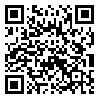Volume 14, Issue 3 (Vol.14, No.3, 2018)
irje 2018, 14(3): 265-271 |
Back to browse issues page
Download citation:
BibTeX | RIS | EndNote | Medlars | ProCite | Reference Manager | RefWorks
Send citation to:



BibTeX | RIS | EndNote | Medlars | ProCite | Reference Manager | RefWorks
Send citation to:
Baridkazemi S, MosaFarkhani E, Eftekhari Gol R, Taghipour A, Bahonar A, Emami O et al . Validity of Self-Reported Diabetes in a Mashhad Population . irje 2018; 14 (3) :265-271
URL: http://irje.tums.ac.ir/article-1-6128-en.html
URL: http://irje.tums.ac.ir/article-1-6128-en.html
S Baridkazemi1 
 , E MosaFarkhani2
, E MosaFarkhani2 
 , R Eftekhari Gol3
, R Eftekhari Gol3 
 , A Taghipour4
, A Taghipour4 
 , A Bahonar5
, A Bahonar5 
 , O Emami6
, O Emami6 
 , HR Bahrami *
, HR Bahrami * 
 7
7

 , E MosaFarkhani2
, E MosaFarkhani2 
 , R Eftekhari Gol3
, R Eftekhari Gol3 
 , A Taghipour4
, A Taghipour4 
 , A Bahonar5
, A Bahonar5 
 , O Emami6
, O Emami6 
 , HR Bahrami *
, HR Bahrami * 
 7
7
1- MSc of Environmental Health Engineering, Mashhad University of Medical Sciences, Imam Reza Hospital, Mashhad, Iran
2- PhD Candidate in Epidemiology, Mashhad University of Medical Sciences, Mashhad, Iran
3- PhD, Department of Health Network Development and Health Promotion, Khorasan Razavi Province Health Center, Mashhad, Iran
4- MD, PhD in Epidemiology, Associate Professor, Social Determination of Health Research Center, Mashhad University of Medical Sciences, Mashhad, Iran
5- Department of Food Hygine and Epidemiology, Faculty of Veterinary Medicine Control, University of Tehran, Tehran, Iran
6- MSc of Epidemiology, Mashhad University of Medical Sciences, Mashhad, Iran
7- MD, MPH, PhD of Chinese Medicine, Associate Professor of Complementary and Chinese Medicine, Faculty of Persian and Complementary Medicine, Mashhad University of Medical Sciences, Mashhad, Iran ,BahramiHR@mums.ac.ir
2- PhD Candidate in Epidemiology, Mashhad University of Medical Sciences, Mashhad, Iran
3- PhD, Department of Health Network Development and Health Promotion, Khorasan Razavi Province Health Center, Mashhad, Iran
4- MD, PhD in Epidemiology, Associate Professor, Social Determination of Health Research Center, Mashhad University of Medical Sciences, Mashhad, Iran
5- Department of Food Hygine and Epidemiology, Faculty of Veterinary Medicine Control, University of Tehran, Tehran, Iran
6- MSc of Epidemiology, Mashhad University of Medical Sciences, Mashhad, Iran
7- MD, MPH, PhD of Chinese Medicine, Associate Professor of Complementary and Chinese Medicine, Faculty of Persian and Complementary Medicine, Mashhad University of Medical Sciences, Mashhad, Iran ,
Abstract: (13532 Views)
Background and Objectives: Researchers and health specialists are increasingly using self-reports to obtain information on chronic illnesses. This study was conducted to assess the validity of self-reports of diabetes based on a recent field survey in Mashhad.
Methods: In this cross-sectional study, we used the results of 2015 census in Mashhad, a population based survey of people over the age of 30 (n =307103), to determine the proportion of self-reported diabetes. The patient records of Sina Electronic Health Record system (SinaEHR®) coded as E11 and E12 approved by doctors were used as a reference. The sensitivity, specificity, positive predictive value, and negative predictive value were calculated with 95% confidence intervals.
Results: The sensitivity, specificity, PLR, NLR, PPV, and NPV of self-reported diabetes was 24.59% (95% CI: 23.97-25.21), 98.04% (95% CI: 97.99-98.09), 12.56% (95% CI: 12.11-13.02), 0.77% (95% CI: 0.76-0.78), 44.77% (95% CI: 43.89-45.67), and 95.27% (95% CI: 95.23-95.31), respectively. The sensitivity of self-reported diabetes was higher in men, Iranian individuals, single subjects, people aged 60 and over, individuals with a BMI of 18.5-25, and those with university education.
Conclusion: Although the sensitivity of self-reported diabetes was poor in this study, its specificity and positive and negative predictive values were good. Furthermore, the sensitivity of self-reported diabetes was higher in men, Iranian individuals, single subjects, people aged 60 and over, individuals with a BMI of 18.5-25, and those with university education. It seems that caution should be exercised in using self-reported data in epidemiological studies.
Methods: In this cross-sectional study, we used the results of 2015 census in Mashhad, a population based survey of people over the age of 30 (n =307103), to determine the proportion of self-reported diabetes. The patient records of Sina Electronic Health Record system (SinaEHR®) coded as E11 and E12 approved by doctors were used as a reference. The sensitivity, specificity, positive predictive value, and negative predictive value were calculated with 95% confidence intervals.
Results: The sensitivity, specificity, PLR, NLR, PPV, and NPV of self-reported diabetes was 24.59% (95% CI: 23.97-25.21), 98.04% (95% CI: 97.99-98.09), 12.56% (95% CI: 12.11-13.02), 0.77% (95% CI: 0.76-0.78), 44.77% (95% CI: 43.89-45.67), and 95.27% (95% CI: 95.23-95.31), respectively. The sensitivity of self-reported diabetes was higher in men, Iranian individuals, single subjects, people aged 60 and over, individuals with a BMI of 18.5-25, and those with university education.
Conclusion: Although the sensitivity of self-reported diabetes was poor in this study, its specificity and positive and negative predictive values were good. Furthermore, the sensitivity of self-reported diabetes was higher in men, Iranian individuals, single subjects, people aged 60 and over, individuals with a BMI of 18.5-25, and those with university education. It seems that caution should be exercised in using self-reported data in epidemiological studies.
Type of Study: Research |
Subject:
Epidemiology
Received: 2019/01/7 | Accepted: 2019/01/7 | Published: 2019/01/7
Received: 2019/01/7 | Accepted: 2019/01/7 | Published: 2019/01/7
Send email to the article author
| Rights and permissions | |
 |
This work is licensed under a Creative Commons Attribution-NonCommercial 4.0 International License. |



